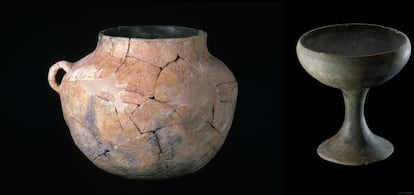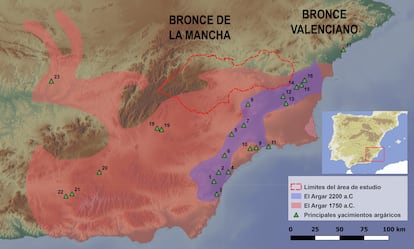Whereas within the East, Egypt was getting into its Center Kingdom, Hammurabi was constructing the Babylonian Empire, and the Minoan tradition of the First Palaces was flourishing in Crete, Western Europe was nonetheless rising from the Neolithic period — besides within the southeast of the Iberian Peninsula.
Between northern Almería and southern Murcia in Spain, the Argaric tradition emerged over 4,000 years in the past. In just some many years, it reached its peak, protecting an space roughly the dimensions of Maine. Dominating copper mining and supported by in depth grain manufacturing on the plains, the Argaric folks had already developed social lessons and a type of aristocratic parliament. Whereas dozens of cities and lots of of settlements are identified, the complete extent of their energy was beforehand unclear. Nonetheless, a latest research of their pottery has make clear the boundaries of this historic civilization.
“Within the Bronze Age, pottery was like plastic as we speak; it was the most typical commodity of the time,” says Adrià Moreno Gil, a researcher on the Max Planck Institute for Social Anthropology in Germany. “They used it for consuming, cooking, storing, transporting… even for burying their useless.”
This observe, specifically, makes the Argaric folks stand out — they buried their family members inside their properties, typically inside massive jars. As with almost each historic tradition, Argaric pottery has distinctive shapes, designs, and types. Classical archaeology has lengthy used these formal variations between pottery sorts to outline distinct cultures. Nonetheless, type alone doesn’t reveal the complete historical past of a tradition.
To uncover extra, Gil Moreno and colleagues from the Autonomous College of Barcelona mapped 1,643 ceramic stays from 61 settlements, a few of which had been Argaric, whereas others belonged to neighboring teams. The outcomes of their work have lately been revealed within the Journal of Archaeological Technique and Concept.
As Moreno Gil explains, in Europe, “small-scale native manufacturing was frequent to satisfy native wants.” Even for types that had been widespread throughout the continent, such because the Bell Beaker, “it wasn’t that these types unfold throughout Europe from a single location; fairly, it was a manufacturing type adopted by varied areas, nevertheless it was nonetheless produced regionally,” he provides.
Nonetheless, in El Argar, issues had been completely different. “First, as a result of it’s standardized; in the remainder of the peninsula, we see a large variability of types. Since everybody made what they might or needed, there have been many alternative types. In distinction, in El Argar, we now have eight types, and all eight are discovered in every single place,” the archaeologist explains. Moreover, a repetitive sample of capacities seems throughout the area. “That tells us that ceramic manufacturing is way more regulated by a central or centralizing entity,” he says.
 On the left, pottery from a settlement on the border of the Argaric territory. On the proper, a cup from the height interval of El Argar’s enlargement. This cup is constituted of pure clay sourced from metamorphic rocks, which made it much less ductile however considerably extra resistant.ASOME-UAB/J.A. Soldevilla
On the left, pottery from a settlement on the border of the Argaric territory. On the proper, a cup from the height interval of El Argar’s enlargement. This cup is constituted of pure clay sourced from metamorphic rocks, which made it much less ductile however considerably extra resistant.ASOME-UAB/J.A. Soldevilla
However they found one thing else. As Carla Garrido, a researcher on the College of Barcelona and co-author of the research, explains: “Historically, archaeology has all the time studied pottery from a stylistic perspective: the form of the piece, the kind of ornament, whether or not it’s painted… However these of us who dedicate ourselves to learning ceramics as a human-made ingredient carry out what’s referred to as an operational chain research, analyzing the whole course of from acquiring the clay to assembling the piece and eventually firing it.”
When learning the clay composition of lots of of items recovered from the 61 settlements, the researchers found that all of them got here from a single web site, maybe two, positioned within the south of what’s now Murcia province. The Argaric ceramics had been constituted of clays sourced from the Sierra de la Almenara, located within the southern a part of modern-day Murcia, on the northernmost tip of the Penibética mountain vary. This web site is a substantial distance from the Argaric settlements farther to the west.
“We’re not speaking about gold, silver, or metals; we’re speaking about ceramics, and in very massive portions,” says Garrido.
The truth that an on a regular basis object, requiring human labor, was being produced in a single place and distributed throughout an unlimited territory — typically over distances of as much as 100 miles — “tells us that the capability for territorial management and materials distribution buildings should have been extremely developed,” provides Moreno Gil.
This centrality and hierarchical construction of manufacturing and distribution function the important thing to defining the boundaries of El Argar. “As soon as we recognized and outlined the kind of paste they used, we started to watch variations on the border websites, the place ceramics made by different teams appeared, merely due to the clay kind. We’re lucky that in El Argar, all the things is so homogeneous,” explains Garrido.
On this approach, the researchers weren’t solely in a position to delimit the boundaries, but additionally to trace the Argaric enlargement itself: “Having the Argaric paste so clearly outlined allowed us to show how the border shifted. In different phrases, we might see the place Argaric ceramics started to appear, with a big presence in some websites to the north,” Garrido says.
 The map illustrates the utmost enlargement of El Argar from its space of origin, in addition to the area the place the research of the ceramics has been carried out.
The map illustrates the utmost enlargement of El Argar from its space of origin, in addition to the area the place the research of the ceramics has been carried out.
The japanese border of El Argar was outlined by the Mediterranean Sea, which additionally marked its southern boundary. To the north, the civilization didn’t lengthen past the Crevillente mountain vary (in Spain’s Alicante province), nevertheless it was to the west the place its territory expanded, and the place pottery has been instrumental in serving to to outline its limits.
This analysis was carried out in solely a portion of the world, specializing in the headwaters and center part of the Segura River valley. “Adrià traveled 150 kilometers from web site to web site,” says Roberto Risch, professor of prehistory on the Autonomous College of Barcelona and the senior creator of the analysis. “However we hypothesize that El Argar had a couple of thousand kilometers of border,” he provides. They hope the pottery will assist verify this.
“Being Argaric isn’t nearly burying your folks in your properties. Being Argaric isn’t nearly having sure taxes. It’s about these eight ceramic types, and never simply their form, however how they’re made,” Risch explains. “All of the pottery from that tradition is made with the identical uncooked materials sourced from very particular mountain ranges, that are additionally the [foundational] territory of El Argar,” he provides.
The research of ceramics additional helps the interpretation of El Argar society as an built-in and cohesive political and financial group, with way more developed techniques for manufacturing and distribution of uncooked supplies and items than beforehand thought. For Risch, “these outcomes considerably assist the speculation that El Argar developed the primary state buildings round 1800 BC in Western Europe.”
Join our weekly e-newsletter to get extra English-language information protection from EL PAÍS USA Version
Writer :
Publish date : 2025-03-17 10:25:00
Copyright for syndicated content material belongs to the linked Source.
The post Ceramics reveal the boundaries of Western Europe’s first state | Tradition first appeared on Love Europe.
—-
Author : love-europe
Publish date : 2025-03-17 19:52:49
Copyright for syndicated content belongs to the linked Source.